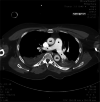Ultrasound-accelerated thrombolysis in high-risk perioperative pulmonary embolism: two case reports and review of literature
- PMID: 34657630
- PMCID: PMC8522031
- DOI: 10.1186/s13741-021-00205-4
Ultrasound-accelerated thrombolysis in high-risk perioperative pulmonary embolism: two case reports and review of literature
Abstract
Introduction: Treatment of high-risk pulmonary embolism (PE) in perioperative patients remains challenging. Systemic thrombolysis is associated with a high risk of major bleedings and intracranial haemorrhage. High mortality rates are reported for open pulmonary embolectomy. Therefore, postoperative surgical patients may benefit substantially from catheter-directed ultrasound-accelerated thrombolysis (USAT).
Case presentation: We report two cases of high-risk perioperative PE. Both patients developed severe haemodynamic instability leading to cardiac arrest. After the implantation of a veno-arterial extracorporeal membrane oxygenation (ECMO), they were both successfully treated with USAT. Adequate improvement of right ventricular function was achieved; thus, ECMO could be successfully weaned after 3 and 4 days, respectively. Both patients showed favourable outcomes and could be discharged to rehabilitation.
Conclusion: Current guidelines on treatment of PE offer no specific therapies for perioperative patients with high-risk PE. However, systemic thrombolysis is often excluded due to the perioperative setting and the risk of major bleeding. Catheter-directed thrombolysis was shown to utilise less thrombolytic agent while obtaining comparable thrombolytic effects. The risk for major bleeding (including intracranial haemorrhage) is also significantly lowered. Until further trials determining the value of adopted treatment strategies of high-risk PE in perioperative patients are available, USAT should be considered in similar cases.
Keywords: Embolectomy; Postoperative; Surgery; Surgical patients.
© 2021. The Author(s).
Conflict of interest statement
The authors declare that they have no competing interests.
Figures




References
-
- Anderson FA, Spencer FA. Risk factors for venous thromboembolism. Circulation. 2003;107(23_suppl_1). 10.1161/01.CIR.0000078469.07362.E6. - PubMed
-
- Avgerinos ED, Mohapatra A, Rivera-Lebron B, Toma C, Kabrhel C, Fish L, Lacomis J, Ocak I, Chaer RA, PERT Consortium Design and rationale of a randomized trial comparing standard versus ultrasound-assisted thrombolysis for submassive pulmonary embolism. J Vasc Surg Venous Lymphat Disord. 2018;6(1):126–132. doi: 10.1016/j.jvsv.2017.09.004. - DOI - PMC - PubMed
Grants and funding
LinkOut - more resources
Full Text Sources

